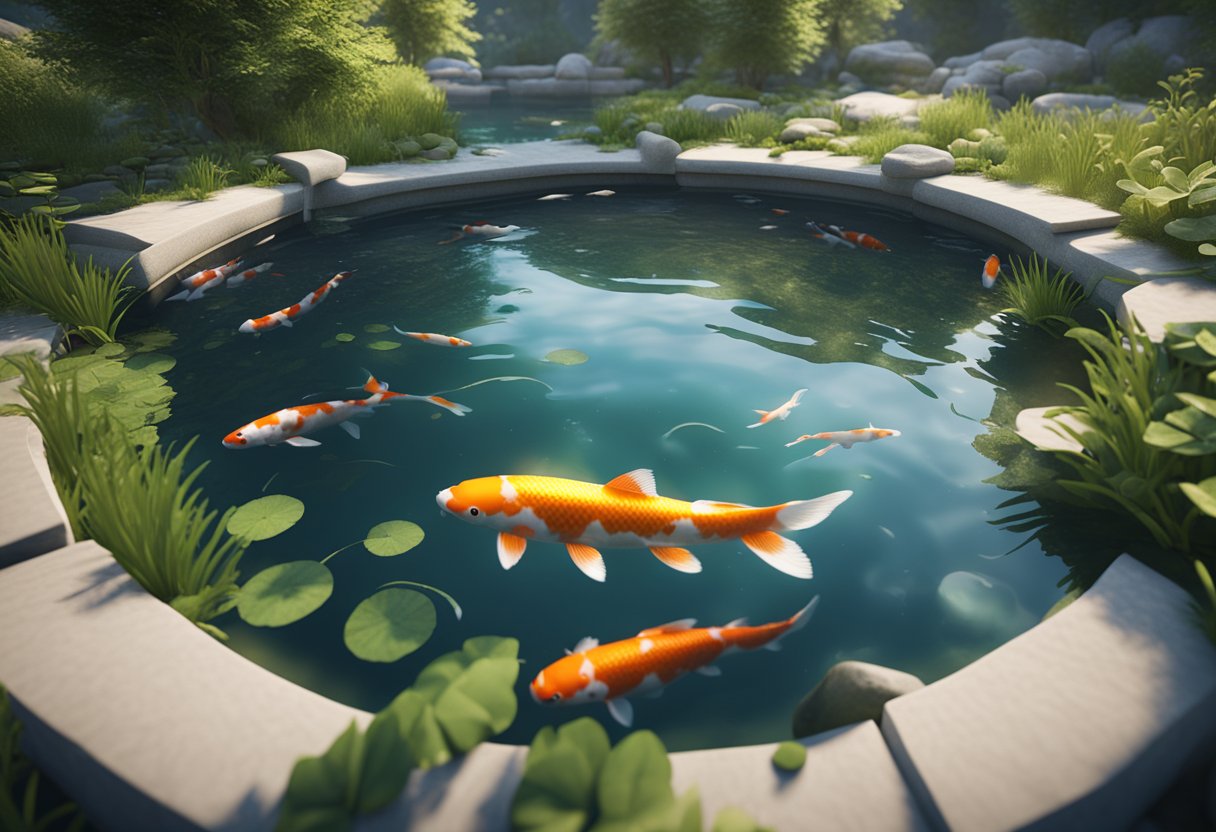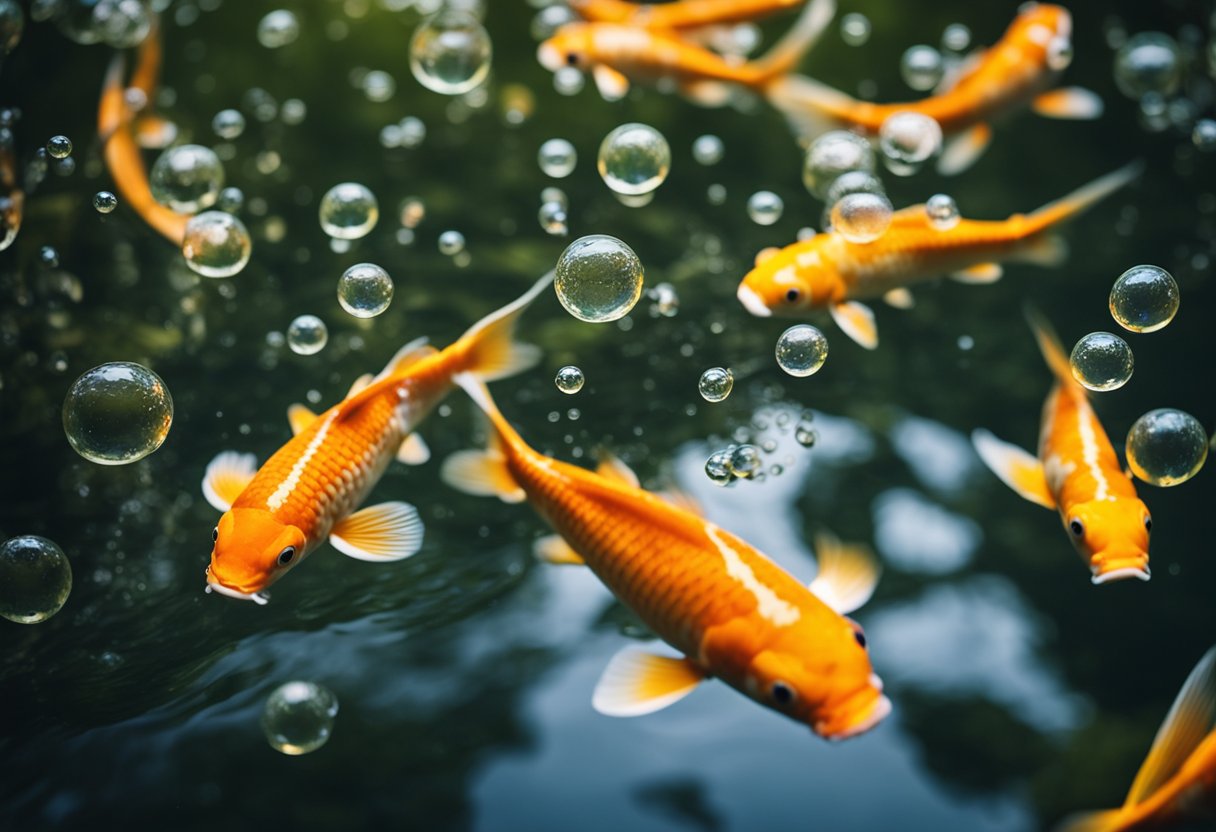Koi fish are a popular choice for pond owners due to their vibrant colors and graceful swimming habits. However, to ensure the health and well-being of these fish, it is important to maintain the appropriate water temperature in their pond. The ideal temperature range for Koi fish can vary depending on several factors, including the time of year and the age of the fish.
During the summer months, when water temperatures tend to be warmer, Koi fish thrive in temperatures between 75-85°F (24-29°C). This temperature range allows the fish to be active and healthy, while also promoting the growth of beneficial bacteria in the pond. However, as the weather begins to cool in the fall, it is important to gradually lower the water temperature to prevent shock to the fish.
In the winter, when water temperatures drop significantly, Koi fish become less active and require a different temperature range to maintain their health. During this time, the ideal water temperature for Koi fish is between 45-65°F (7-18°C). Maintaining this temperature range can help to prevent stress and illness in the fish, ensuring they remain healthy throughout the winter months.
Koi Fish Temperature Requirements

Koi fish are cold-blooded creatures that rely on their environment to maintain their body temperature. As such, it is crucial to understand their temperature requirements to ensure their health and well-being. This section will cover the optimal temperature range for koi health and their temperature tolerance limits.
Optimal Temperature Range for Koi Health
Koi fish thrive in water temperatures between 65°F and 75°F (18°C to 24°C). This temperature range provides the ideal conditions for koi growth, metabolism, and immune system function. When water temperatures fall below 65°F, koi fish become sluggish, and their metabolism slows down, making them more susceptible to disease. On the other hand, water temperatures above 75°F can lead to stress, oxygen depletion, and increased risk of bacterial and parasitic infections.
It is important to note that koi fish are highly adaptable creatures and can tolerate a wide range of temperatures. However, sudden changes in water temperature can be harmful to their health. Therefore, it is recommended to maintain a consistent water temperature within the optimal range for koi health.
Temperature Tolerance Limits
Koi fish can tolerate water temperatures between 35°F and 90°F (2°C to 32°C). However, these extreme temperatures should be avoided as they can cause significant stress and health problems for koi fish. Water temperatures below 35°F can lead to hypothermia, while water temperatures above 90°F can cause heat stress and oxygen depletion.
In conclusion, maintaining the optimal temperature range for koi fish is essential for their health and well-being. It is recommended to monitor water temperature regularly and take necessary measures to maintain a consistent temperature within the optimal range.
Seasonal Temperature Considerations for Koi Ponds

Winter Care
During the winter season, it is important to maintain a steady temperature in the pond to ensure the health and survival of Koi fish. The ideal temperature range for Koi fish during winter is between 39°F and 50°F (4°C and 10°C). If the temperature drops below this range, the fish may become lethargic and may even stop eating.
To maintain the ideal temperature range, it is recommended to use a pond heater or a de-icer. A pond heater can maintain a steady temperature in the pond by heating the water. On the other hand, a de-icer is used to keep a small area of the pond free from ice, allowing for gas exchange and preventing the buildup of harmful gases.
It is also important to reduce the amount of food given to the fish during winter as their metabolism slows down in colder temperatures. Overfeeding can lead to health problems such as bloating and constipation.
Summer Management
During the summer season, the temperature of the pond can rise, which can lead to stress and health problems for Koi fish. The ideal temperature range for Koi fish during summer is between 68°F and 77°F (20°C and 25°C). If the temperature rises above this range, it can lead to oxygen depletion and the buildup of harmful gases.
To maintain the ideal temperature range, it is recommended to provide shade for the pond using plants or a shade cloth. This can help to reduce the amount of direct sunlight and heat that the pond receives. It is also important to ensure that the pond has adequate aeration to maintain oxygen levels in the water.
During summer, it is important to feed the fish regularly but in smaller amounts to prevent overfeeding and water pollution. It is also recommended to monitor the water quality regularly to ensure that the pond is healthy and free from harmful bacteria and parasites.
Effects of Temperature Fluctuations on Koi
Koi fish are cold-blooded creatures that rely on their environment to regulate their body temperature. Therefore, temperature fluctuations in their pond can have a significant impact on their health and well-being. In this section, we will explore the effects of temperature fluctuations on Koi fish, including their metabolism, stress levels, and immunity.
Impact on Metabolism
Temperature plays a crucial role in the metabolism of Koi fish. When the water temperature drops below their ideal range, their metabolism slows down, and they become less active. As a result, their digestion and nutrient absorption also slow down, leading to a decrease in appetite and growth rate. On the other hand, when the water temperature is too high, their metabolism speeds up, and they require more oxygen to maintain their bodily functions. This can lead to oxygen depletion in the pond, which can be fatal to the fish.
Stress and Immunity Issues
Temperature fluctuations can also cause stress and weaken the immune system of Koi fish. When the water temperature changes rapidly, it can cause shock and stress to the fish, making them more susceptible to diseases and infections. Moreover, temperature fluctuations can disrupt the balance of beneficial bacteria in the pond, leading to an increase in harmful bacteria that can cause infections and diseases.
In conclusion, maintaining a stable temperature range in the pond is crucial for the health and well-being of Koi fish. Any significant temperature fluctuations can have a severe impact on their metabolism, stress levels, and immunity, leading to decreased appetite, growth rate, and increased susceptibility to diseases and infections. Therefore, it is essential to monitor the water temperature regularly and take necessary measures to maintain a stable temperature range.
Maintaining Ideal Pond Temperatures
Koi fish are cold-blooded creatures, and their metabolism is directly affected by the temperature of the water in their pond. Therefore, it is essential to maintain the ideal temperature range for their health and well-being.
Heating Solutions
During the colder months, the water temperature in the pond may drop below the ideal range. In such cases, it is necessary to provide a heating solution to maintain the desired temperature. There are several options available, including:
- Heaters: Electric heaters are the most common heating solution for ponds. They are easy to install and can be controlled using a thermostat to maintain the desired temperature. However, they can be expensive to operate, and the cost may vary depending on the size of the pond.
- Heat Pumps: Heat pumps are an energy-efficient alternative to electric heaters. They work by extracting heat from the air and transferring it to the water. They are more expensive than electric heaters but can save money in the long run.
- Solar Heaters: Solar heaters are an eco-friendly and cost-effective option for heating ponds. They work by using solar panels to collect energy from the sun and transfer it to the water. However, they may not be suitable for colder climates or areas with limited sunlight.
Cooling Strategies
In warmer climates or during the summer months, the water temperature in the pond may rise above the ideal range. To prevent this, it is necessary to implement cooling strategies. Some effective cooling strategies include:
- Shade: Providing shade over the pond can help reduce the water temperature. Trees, umbrellas, and shade cloth are some options for providing shade.
- Aeration: Aeration can help cool the water by increasing the oxygen levels and promoting circulation. Fountains, waterfalls, and air pumps are some options for providing aeration.
- Evaporation: Evaporation can help cool the water by removing heat from the surface. However, it may not be effective in humid climates.
In conclusion, maintaining the ideal temperature range is essential for the health and well-being of Koi fish in their pond. By implementing the appropriate heating and cooling strategies, pond owners can ensure that their Koi fish thrive in a comfortable environment.
Monitoring and Adjusting Water Temperature
Thermometers and Temperature Gauges
To ensure that the water temperature in a Koi pond remains within the ideal range, it is essential to have the right tools for monitoring and adjusting it. One of the most important tools is a thermometer or temperature gauge, which allows the pond owner to keep track of the water temperature at all times. There are various types of thermometers and gauges available on the market, including digital, analog, and floating models. It is recommended to choose a thermometer or gauge that is easy to read and accurate.
Regular Temperature Checks
To maintain the ideal temperature range for Koi fish, regular temperature checks are necessary. This means checking the water temperature at least once a day, preferably at the same time each day, to ensure that it remains within the recommended range. If the temperature is too high or too low, steps must be taken to adjust it. For example, if the water temperature is too high, adding shade to the pond or increasing aeration can help lower it. Conversely, if the water temperature is too low, a pond heater or insulation can help raise it.
Overall, monitoring and adjusting the water temperature in a Koi pond is crucial for the health and well-being of the fish. By using the right tools and regularly checking the temperature, pond owners can ensure that their Koi fish are kept in a comfortable and safe environment.

As a dedicated veterinarian and animal enthusiast, I, Phoebe Wright, bring a unique perspective to my writing about Koi Fish. With my expertise in animal care, I strive to share valuable insights in a friendly and approachable manner, making my posts both informative and enjoyable to read.







